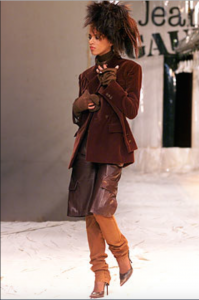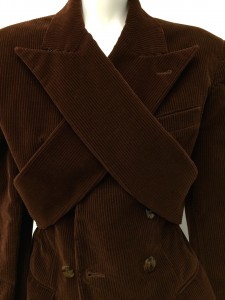Blog post by Aidan Shiller (’18)
This corduroy blazer from Jean Paul Gaultier’s Femme line is an exquisite example of his aesthetic vision. It was first seen on the runway as look #44 (of 69) in Gaultier’s Fall 2002 ready to wear (RTW) collection. The jacket was donated to the Cornell Costume and Textile Collection by Lee A. Sheppard in 2005. At first glance Gaultier’s design appears very similar to most blazers, but upon closer investigation is full of unusual details, some of which go as far as contradicting blazer norms. This wouldn’t be Gaultier’s first time challenging “jacket norms,” as evidenced by the “backwards jacket” in his 1985/6 winter collection. The corduroy blazer in CCTC’s collection features exaggerated peak lapels that extend, cross, and button in the back. It is double breasted, features surgeon cuffs, and includes a locker loop on the back under the collar.
The blazer is a runway sample, which means that no identifying tags have been included inside the garment to indicate size, brand, gender, or fiber content. When I first saw this blazer I thought it was a men’s jacket and I did not find out otherwise until I tried to put the jacket on a male mannequin. Gaultier created a casual woman’s jacket that uses a powerful silhouette, formal detailing, workwear-esque material, and traditionally masculine athletic design details. This jacket epitomizes Gaultier’s design philosophy: he uses familiar shapes and details to create a familiar garment, but from there he twists and contorts atypical details to make familiarity strange and push his audience to think.
The distinguishing feature of this jacket is the floating, crossed lapels. The jacket takes cues from formalwear in that it is double-breasted and has exaggerated peak lapels. The lapels are so conspicuous that they would typically only be appropriate in the most formal settings, like white tie affairs. However, in this iteration, Gaultier has created the entire blazer out of corduroy, which was traditionally used to make country clothing because of its durability. In doing so Gaultier invites his audience to start a conversation. Some may be drawn to the socioeconomic commentary, and others may fixate on the conversation about gender.
The origins of the blazer in America can be traced back to Ivy League athletics. The blazer was originally designed as a way to keep rowers warm, and later became a staple to identify graduation class year. The Cornell Costume and Textile Collection has a number of class blazers and reunion blazers, which were loaned to the Museum at FIT for their 2012 Ivy Style exhibition. Gaultier’s blazer is particularly interesting because it embraces the dialectical tensions between casual and formal, and masculinity and femininity.
Another homage to the Ivy League is the locker loop found at the back of the jacket. In the blog, Retrospective Modernism, Scott Fraser Simpson explains that the locker loop was originally designed for sailors to hang their coats without the need for traditional hangers; however, in the 1960s these locker loops began showing up on streetwear. Many preppy brands of the time started using this detail, and it became a staple within Ivy League dress. Interestingly enough locker loops could denote relationship status. If a man was seen walking around with his locker loop removed it meant that he was taken. The locker loop is an ironic detail on this jacket for two reasons: (1) you would never hang a jacket of this quality by a locker loop and (2) it is a woman’s jacket which contradicts the gendered adaptation of the loop from the 1960s.

During the early aughts Gaultier played around with distorting and modifying traditional garments like this blazer. During this period many of his contemporaries such as John Galliano, Alexander McQueen, and Rei Kawakubo played with distorting common clothing to create something new. This example is a milder example, but some blazers of this period were severely deconstructed and distorted. Some designers contorted silhouettes beyond recognition. In recent years Gaultier’s influence has been seen on the runway in Givenchy’s Fall/Winter 2014 blazers and bombers and Hood By Air’s highly distorted Spring/Summer 2015 blazers.
Ultimately, this blazer opens up space for social commentary because Gaultier created an article of clothing that is highly recognizable and stereotypical in some ways, but undermines those same stereotypes in other ways. Most people who see this blazer will be able to identify the social references ensnared in the jacket’s form and details. The genius of the jacket is obscured, and does not become apparent until you try to connect the design features. Many of the details embrace contradiction, and when the viewer tries to connect the dots, a visual and tactile conservation begins.



